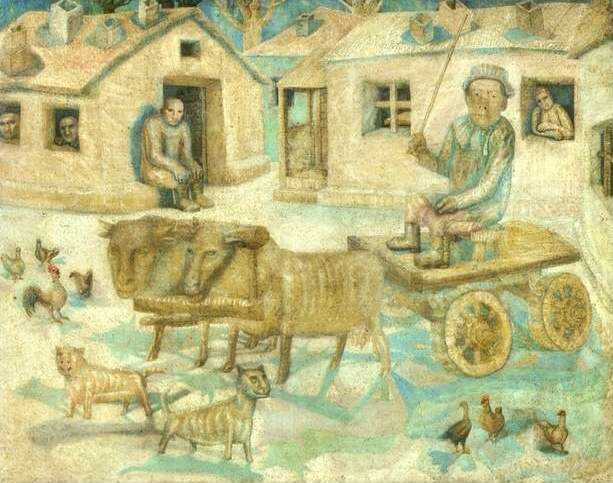Description
The oil on canvas "oxen. Scene of the life of the savages - 1918" by Pavel Filonov is emerging as a work in which the viewer is confronted with a composition of intensity and complexity without concessions. By carefully observing this painting, the meticulousness with which Filonov approached each line and color is evident, in a representation that, although it may seem chaotic, is impregnated with a deep meaning and a deliberate structure.
The work presents a scene composed of multiple oxen, located in what can be interpreted as an aggregate and primitive landscape, an echo of life in ancestral times. Animals, although configured with shapes that are, at first glance, abstract, do not lose their natural essence. Filonov uses a technique of fragmentation of the pictorial space that achieves an almost oppressive dynamism, guiding the viewer's gaze through a visual labyrinth of superimposed lines and colors.
"Oxen. Scene from The Life of Savages - 1918" is inscribed within the context of Rayonism and Russian cubofuturism, movements with which Filonov is indirectly related, although with a very particular and revolutionary vision. Filonov, throughout his career, developed what he called "analytical realism", a style that sought to decompose reality in its most essential components and then rebuild it on the canvas, providing it with a new dimension of meaning.
The use of color in this paint is worthy of detailed analysis. Filonov uses a reduced but powerful palette that emphasizes terrible, ocher and dark green tones, allowing oxen to integrate perfectly into the environment that suggests a wild and primary world. The contours of the figures are schematically delineated and intertwined with geometric elements that seem to vibrate and move, generating a sense of energy contained.
The composition, although motley, follows an internal logic. The oxen, often considered symbols of patience and industriousness, seem here to embody an integral part of nature, almost indistinguishable from the surrounding landscape. There are no human figures present, which reinforces the idea of a world in which the human being has not yet left his dominant mark.
The brushstrokes and textures used by Filonov are unique in their kind. The almost obsessive thoroughness with which each segment of the canvas has been worked creates a vibrant surface and saturated with details, which demand a prolonged observation to be completely appreciated. This technique, which can remind the precision of a craftsman creating a thorough mosaic, is a reflection of the artist's dedication and philosophical approach to his work.
Filonov, who spent much of his life in St. Petersburg, was both a visionary and an iconoclast. His methodology was rigorous and spiritual, and his art often left both contemporaries and critics perplexed. His legacy, although not as universally recognized as that of other contemporaries of his, has grown up over time, offering a window to an approach to modernity that combines the ancestral with the futuristic.
In "Oxes. Scene of the life of the savages - 1918", Filonov invites us to a trip to the core of reality, to a reflection on the coexistence of the civilized and the wild, through a pictorial meditation that, although rooted In the past, it resonates with a clarity and relevance that cross the twentieth century to get intact to this day.
KUADROS ©, a famous paint on your wall.
Hand-made oil painting reproductions, with the quality of professional artists and the distinctive seal of KUADROS ©.
Art reproduction service with satisfaction guarantee. If you are not completely satisfied with the replica of your painting, we refund your money 100%.

